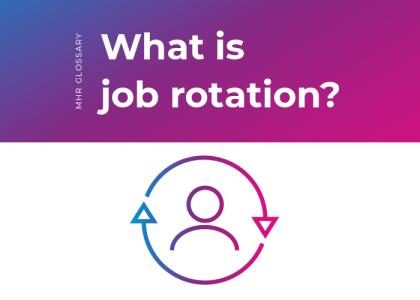What is Job Rotation?
Job rotation is a human resource (HR) strategy where employees are moved between two or more assignments or roles within an organisation over a period of time. This practice is designed to give employees a variety of experiences, skills, and competencies, as well as to reduce job monotony and increase motivation. Here’s an in-depth look at what job rotation entails and its benefits.
Understanding Job Rotation
Job rotation involves systematically moving employees to different jobs or tasks within an organisation. These moves can be lateral (moving to a job with similar responsibility) or vertical (promoting to a higher role). The rotations can be planned for fixed durations or be flexible based on the needs of the organisation and the development plan for the employee.
What is the main aim of Job Rotation?
The strategy is simple; to reduce the boredom of doing same type of job every day and to find the hidden skills and potentials of an employee. This affects the purpose of both the management and the employees, in that it helps management in discovering the talent of employees and determines what that employee may also be best at. It also gives an individual the chance to explore their own plans and goals, or to gain more experience in different fields or operations.
What are the key objectives of Job Rotation?
There are five main objectives of Job Rotation, for both employer and employees.
Skill Development: By exposing employees to various roles, they develop a broader skill set, making them more versatile and valuable to the organisation.
Employee Engagement and Motivation: Rotation helps keep the work environment dynamic, reducing monotony and increasing job satisfaction.
Talent Management: The process helps in identifying the best fit for a particular role and uncovering hidden talents.
Succession Planning: Rotation prepares employees for higher responsibilities, ensuring a seamless transition when key positions need to be filled.
Operational Flexibility: Employees who experience and understand multiple roles can step in during absences or peak periods, enhancing operational efficiency.
Different types, methods and examples of Job Rotation techniques
There are many different types and methods of job rotation, each with specific objectives and benefits. Here’s a simple explanation and closer look at some of these:
Types of Job Rotation
Task Rotation
This is where employees rotate through different tasks within the same job or department. An example is where a customer service representative might handle phone calls one week and email inquiries the next.
Position Rotation
Employees move between different positions within the same organisation. An example could be where a marketing specialist rotates to a sales position to gain a better understanding of customer interactions.
Cross-Functional Rotation
Employees rotate across different departments or functional areas. The objective is for them to gain a holistic understanding of the organisation, and identify leadership potential. An example could be where an employee spends six months in finance, then moves to operations, and later to human resources.
Geographical Rotation
Employees rotate across different departments or functional areas. The objective is for them to gain a holistic understanding of the organisation, and identify leadership potential. An example could be where an employee spends six months in finance, then moves to operations, and later to human resources.
Putting Job Rotation into effort
We’ve explored the different types of Job Rotation. But what are the different kinds of methods to put Job Rotation into practice in an organisation?
Planned Rotations
These are structured and pre-determined rotation schedule, often part of a formal development program. They are to systematically develop skills and prepare employees for leadership roles.
Ad Hoc Rotations
These are rotations implemented on an as-needed basis, often to fill immediate gaps or address specific challenges, to provide flexibility and meet short-term organisational needs.
Job Swapping
This is usually where two employees exchange roles for a set period, to share knowledge, understand different roles, and improve collaboration.
Sequential Rotation
Usually, employees rotate through a series of predefined positions in a specific order to ensure comprehensive exposure to various aspects of the business.
Temporary Assignments
Employees take on different roles or projects for a limited time, without a permanent change in position, to develop specific skills and provide career development opportunities.
So what are the disadvantages of Job Rotation?
Implementing job rotation in your organisation can offer numerous benefits, but it also can bring with it several challenges. Here are some of those and considerations for addressing them:
- Disruption to Workflow: Rotations can disrupt workflow and productivity. A solution could be to plan rotations carefully to avoid critical project times.
- Training and Learning Curve: New roles can require training and adjustment. A solution can be to provide comprehensive training and mentoring.
- Employee Resistance: Employees may resist change. A management solution could be to communicate benefits clearly and offer incentives.
- Impact on Morale: Unwanted rotations can lower morale. The organisation could involve employees in planning and consider their preferences.
- Resource Allocation: Rotations can require additional resources, so allocate sufficient budget and use technology for training.
- Consistency and Continuity: Rotations can lead to inconsistencies in work quality, so it’s good to establish clear SOPs and monitor performance.
- Knowledge Transfer: Critical knowledge may be lost. In transition, so a plan is to implement structured handover processes.
- Career Path Concerns: Employees worry about career impact. Implement map career paths and provide regular feedback.
- Cultural and Interpersonal Issues: Adjusting to new teams can be difficult. Promote inclusivity and team-building activities.
Job rotation enhances skills and motivation but requires careful planning and support to address its challenges. A proper management strategy ensures a successful program that benefits both employees and the organisation.
Benefits outweigh the negatives
Job rotation can significantly enhance business productivity by growing a dynamic and versatile workforce. The benefits of Job Rotation for business productivity very much outweigh the negatives:
Employees gain a broad range of skills, increasing workforce versatility and enabling them to handle multiple tasks and roles effectively.
Rotating roles reduces monotony, keeping employees engaged and motivated, which leads to higher productivity levels.
Job rotation helps identify hidden talents and strengths, ensuring optimal use of employee capabilities and improving overall efficiency.
Employees understand different roles and responsibilities, creating better communication and collaboration across departments, thereby enhancing productivity.
Variety in job roles prevents burnout, maintaining high energy and productivity levels among employees.
Exposure to various roles encourages creative thinking, enabling employees to bring innovative solutions and ideas, which boost business productivity.
Cross-trained employees can fill in for absences or peak periods, ensuring continuity and smooth operations, thereby minimising downtime.
Planning Job rotation prepares employees for higher responsibilities, ensuring a smooth transition during promotions or role changes and maintaining productivity.
Opportunities for growth and learning increase job satisfaction and lower turnover rates, helping retain skilled employees.
Job rotation enhances business productivity by developing a skilled, motivated, and versatile workforce. This leads to better collaboration, innovative problem-solving, and operational flexibility, ultimately driving the organisation's success.
Which Industries benefit from Job Rotation, and why?
Job rotation is a versatile practice used across various industries to enhance employee skills, engagement, and operational efficiency. Here are some examples of industries that commonly utilise job rotation:
Manufacturing
Assembly line workers rotate between different stations to learn various tasks, such as quality control, machine operation, and packaging.
Benefits: Reduces monotony, prevents repetitive strain injuries, and ensures a versatile workforce that can cover multiple roles.
Healthcare
Nurses and medical staff rotate through different departments, such as emergency, paediatrics, and intensive care units.
Benefits: Broadens clinical skills, improves patient care through diverse experiences, and prepares staff for various medical scenarios.
Retail
Employees rotate between roles such as cashier, stock replenishment, customer service, and sales.
Benefits: Enhances understanding of store operations, improves customer service, and develops a flexible workforce that can cover for absences.
Finance and Banking
Bank employees rotate through departments like loans, customer service, risk management, and investment services.
Benefits: Increases knowledge of financial products and services, improves risk management skills, and prepares employees for leadership roles.
Information Technology (IT)
IT professionals rotate between roles such as software development, network administration, cybersecurity, and technical support.
Benefits: Broadens technical expertise, fosters innovation through diverse experiences, and ensures comprehensive understanding of IT infrastructure.
Education
Teachers and academic staff rotate between different subjects, grade levels, and administrative roles.
Benefits: Enhances teaching skills, fosters a well-rounded educational approach, and prepares staff for various academic responsibilities.
Hospitality
Hotel employees rotate through positions such as front desk, housekeeping, food and beverage service, and event planning.
Benefits: Provides comprehensive understanding of hotel operations, improves customer service, and develops a versatile staff.
Government and Public Sector
Civil servants rotate between different departments such as finance, human resources, public relations, and policy development.
Benefits: Broadens understanding of governmental functions, improves policy-making skills, and enhances public service delivery.
Logistics and Supply Chain
Employees rotate between roles in inventory management, transportation, warehousing, and procurement.
Benefits: Enhances operational efficiency, reduces bottlenecks, and develops a comprehensive understanding of the supply chain process.
Aerospace and Defence
Engineers and technicians rotate through roles in design, testing, production, and maintenance.
Benefits: Broadens technical expertise, encourages innovation, and ensures a thorough understanding of complex aerospace systems.



